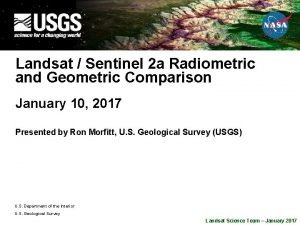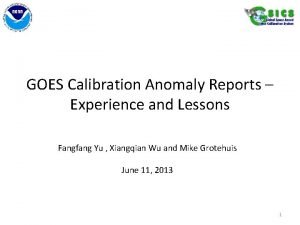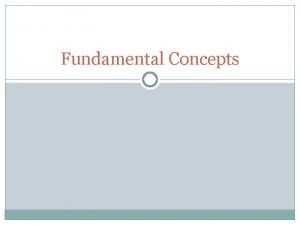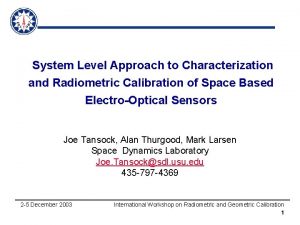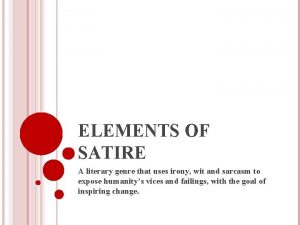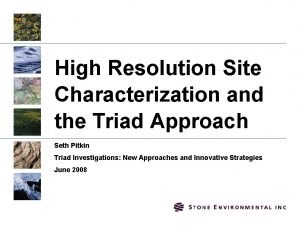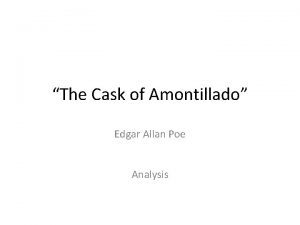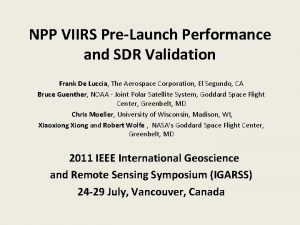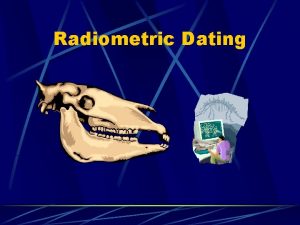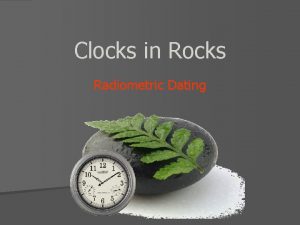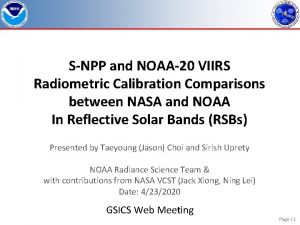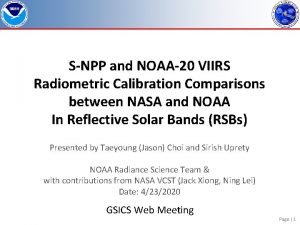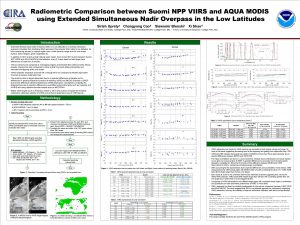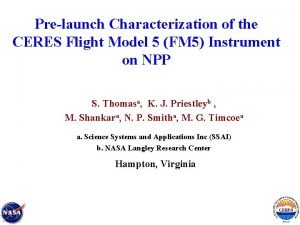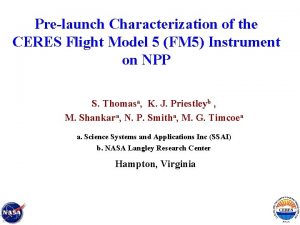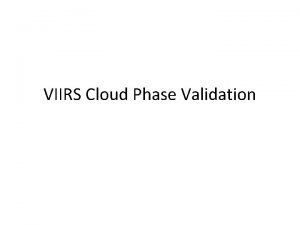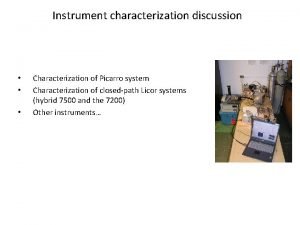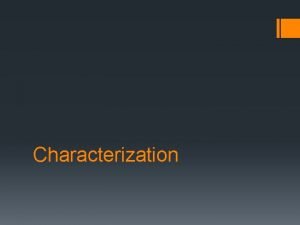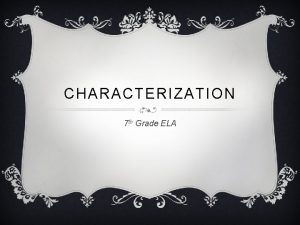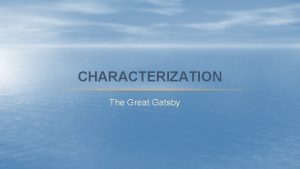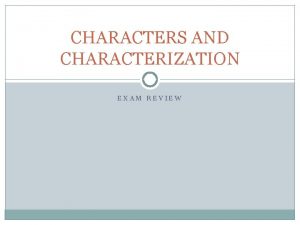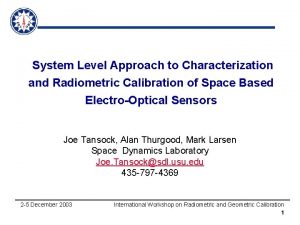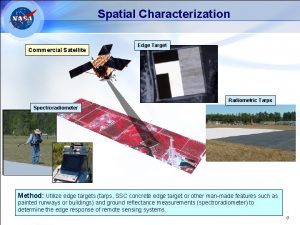JPSS3 VIIRS PreLaunch Radiometric Performance VIIRS Characterization Support

























- Slides: 25

JPSS-3 VIIRS Pre-Launch Radiometric Performance VIIRS Characterization Support Team, NASA GSFC Presented by Jeff Mc. Intire Courtesy of NASA SNPP Land SIPS – S. Devadiga & P. Ma Calibration Workshop: February 25, 2021 Acknowledgements: Government Data Analysis Working Group (DAWG), NASA VIIRS On-site Instrument Team 1

Content • JPSS-3 VIIRS Pre-launch Testing • JPSS-3 VIIRS Improvements • JPSS-3 Performance Waivers • Status of JPSS-3 VIIRS Performance Assessment • Conclusion 2

VIIRS Sensor & On-board Calibrators SDSM Cryoradiator Door Solar Diffuser OPTO-MECH Module Solar Attenuator Screen (SAS) Solar Diffuser Stability Monitor Rotating Telescope Assembly Electronics Module NADIR Aperture Door § Proven design through SNPP and JPSS-1 missions on-orbit § Comprehensive pre-launch testing, and on-orbit predictions Blackbody (BB) 3

Overview of JPSS Pre-launch Testing JPSS-1 JPSS-2 JPSS-3 Key Testing Ambient 8/2013 - 1/2014 4/2016 – 8/2016 10/2019 – 1/2020 SNR/NEd. T, dynamic range, polarization, RVS, stray light, BB/SD/SDSM characterization, RSR (GLAMR), spatial (LSF/MTF/BBR) TVAC 7/2014 - 10/2104 4/2017 – 12/2017 9/2020 – 2/2021 SNR/NEd. T, dynamic range, calibration, RSR (Sp. MA), spatial (LSF/MTF/BBR) SC TVAC 4/2016 – 9/2016 4/2017 10/2021 TBD SNR/NEd. T, calibration (FPI and OBC BB) Launch 10/2017 10/2022 2026 q Radiometric, Spectral and Spatial testing Ø q Ensure sensor performance meets design requirements Ø q SDR LUTs, etc. Modeling and predictions for science data quality Ø q Compliance, waivers Generate performance parameters for on-orbit operation Ø q Ambient, TVAC (cold, nominal, hot), HAM sides, E-sides, detectors, etc. Unexpected changes on-orbit, etc. Develop mitigation strategies for performance issues Correction algorithms, TestØprogram developed with etc. lessons from S-NPP and JPSS-1/2 VIIRS Test data independently analyzed and results extensively reviewed 4

J 1/J 2/J 3 Sensor Improvements JPSS-1 • • RTA Mirrors Changed from Ni coated to VQ to improve spatial stability with temperature Dichroic 2 Coatings Redesigned to improve spatial performance between SMWIR and LWIR Eliminated Throughput Degradation due to Tungsten as seen on SNPP to improve radiometric sensitivity Enhanced Vis. NIR integrated Filter coating change to reduce crosstalk and OOB. Higher polarization sensitivity resulted in bands M 1 – M 4 BAE SBC replaced Honeywell SBC (for single event anomaly on-orbit) Improved interface between HAM and RTA motor to prevent scan-sync loss on-orbit Spacewire replaced IEEE 1394 as the spacecraft BUS JPSS-3 JPSS-2 • • • Vis. NIR FPA detectors redesigned to eliminate dynamic crosstalk Vis. NIR FPA ROIC circuit reworked to address rollover after Lsat Integrated filter assemblies (IFAs) for all focal planes (except DNB) redesigned to improve dynamic range and reduce Vis. NIR polarization sensitivity Dichroic beamsplitter mounting fixed to improve BBR between Vis. NIR and cold FPAs SDSM spectral filters redesigned to reduce out-of-band signal. Additional baffling and closeouts to reduce stray light for the DNB. • • Dichroic beamsplitter #1 redesigned to decrease polarization splitting in M 1 Additional baffling and closeouts to reduce stray light for the DNB. Other improvements were also included but are not expected to make substantial changes in the sensor performance 5

JPSS-3 VIIRS Performance Waivers JPSS-3 Wavier Title SNPP / JPSS-1 W 181 DNB stray light in certain viewing geometries W 053 D / RDW 150 B W 182 / W 182 A Relief from relative spectral response W 116 / W 161 W 049 A / W 161 W 183 M 1 predicted sensor polarization sensitivity W 166 W 184 / W 184 A Near field response relief W 112 A / W 168 W 186 / W 186 A DNB uniformity W 126 / W 173 W 187 Band to band registration for Imaging band W 024 B / W 173 W 188 / W 188 B Emissive relative radiometric response characterization uncertainty W 070 B / W 171 W 190 Reflective band uniformity W 113 / W 172 W 191 / W 191 A M and I band crosstalk W 054 A / W 153 W 192 Reflective relative radiometric response W 113 / W 172 W 193 DNB crosstalk W 054 A / W 153 W 214 DNB spatial performance (HSI) W 215 M 12 near field response • • • Some waivers still pending NASA / NOAA approval (TVAC just finished) Compliance is against endof-life (EOL) performance All non-compliances have mitigation plans, or expected to lead to acceptable impact. Vis. NIR band MTF and HSR M 12 emissive response uniformity 6

7 JPSS-3 Performance Summary Results derived from Pre-TVAC and TVAC testing are preliminary 7

JPSS-3 VIIRS Performance • JPSS-3 RSB Radiometric Performance: – JPSS-3 VIIRS meets all requirements for SNR, Dynamic Range, Gain Transition • Successful JPSS-3 RSB radiometric calibration in TVAC. Overall, as good as JPSS-2. • Minor non-compliances for uniformity (consistent with earlier VIIRS builds). – Other JPSS-3 RSB performance characteristics of note • M 1 polarization factor less than 2. 7 % (JPSS-2 had 4. 7 % and JPSS-1 had 6. 4 %). • JPSS-3 DNB Radiometric performance: – JPSS-3 VIIRS meets all requirements for SNR, Dynamic Range • Successful JPSS-3 DNB radiometric calibration in TVAC. Overall, as good as JPSS-2. • Minor non-compliances for uniformity (consistent with earlier VIIRS builds). • Select aggregation zones show slight nonlinearity near solar tie point, which could affect gain ratios. JPSS-3 results derived from Pre-TVAC and TVAC testing are preliminary 8

JPSS-3 VIIRS Performance • JPSS-3 TEB Radiometric Performance – JPSS-3 VIIRS meets all requirements for Noise (NEd. T), Dynamic Range, Uncertainty and Uniformity. • TEB showed excellent calibration performance based on the TVAC testing; comparable to JPSS-1 or JPSS-2 performance. • Non-compliance of OBC-BB non-uniformity was observed during TVAC (up to ~40 m. K vs. 30 m. K Spec). Not observed on JPSS-1; JPSS-2 showed worse non-uniformity (up to ~50 m. K). • FPAs set to 80 K. Slightly better than JPSS-2, which was set to 82 K. • JPSS-3 Spectral Performance • Successful spectral testing based on NASA GLAMR (Vis. NIR and SWIR) and Raytheon Sp. MA. JPSS-3 performance in general as good as JPSS-1 or JPSS-2. – Minor non-compliances for M 1 and M 15 center, M 14 and M 16 bandwidth. – Merger of Sp. MA and GLAMR data sets ongoing. JPSS-3 results derived from Pre-TVAC and TVAC testing are preliminary 9

RSB Radiometric Performance JPSS-3 SNR compliant with large margin JPSS-3 saturation radiance above spec JPSS-3 RSB calibration performance is very good, similar to SNPP / JPSS-1 / JPSS 2. Minor non-compliances: uniformity. 10

DNB Radiometric Performance LGS mode 29 Solar radiance - JPSS-3 VIIRS DNB performance good overall. - Some nonlinearity observed near solar tie point in LGS for select aggregation modes. Could influence gain transfer to MGS and HGS. - Uniformity issues similar to previous builds. 11

Counts TEB Radiometric Performance Radiance - JPSS-3 TEB calibration performance is very good, similar to SNPP / JPSS-1 / JPSS-2. Minor non-compliances observed: OBC BB uniformity, characterization uncertainty, detector uniformity 12

RSR and Scattered Light NFR: M 1, Det 8 Vis. NIR RSR • Successful JPSS-3 spectral testing based on NASA GLAMR (Vis. NIR and SWIR) and Raytheon Sp. MA. – • JPSS-3 NFR test data quality is very good. – • All band meet the requirements. JPSS-3 stray light performance also very good. – • Limited non-compliances: M 1 and M 15 band centers; M 14 and M 16 bandwidths. All bands meet the requirements. DNB investigation ongoing. Results are comparable to JPSS-1 / JPSS-2. 13

Response Versus Scan (RVS) • • SNPP J 1 • J 2 JPSS-3 RVS performance comparable to SNPP, JPSS-1, and JPSS-2. Similar RVS between HAM sides (differences were present on JPSS-1) Uncertainties were within tolerances. J 3 14

15 Polarization Performance • JPSS-3 VIIRS has shown compliance for all bands – Largest Do. LP was for band M 1 (2. 7 %) – JPSS-3 comparable to SNPP; better than JPSS-1 and JPSS-2 • JPSS-1 had non-compliances for bands M 1 -M 4 due to filter and dichroic issues • JPSS-2 had non-compliance for band M 1 due to a dichroic issue • Redesign of the filters and dichroic led to improved performance SNPP JPSS-1 JPSS-2 JPSS-3 15

Summary of VIIRS Key Issues • JPSS-3 Key Issues – OBC BB non-uniformity to be monitored, better than JPSS-2 but worse than SNPP / JPSS-1. – DNB nonlinearity observed in some aggregation zones near the solar tie point; could affect the gain transfer from LGS to MGS and HGS. • Other Issues/topics: – Low cryo-cooler margins observed late in TVAC for JPSS-3. Currently under investigation by Raytheon (possible cryo target configuration issue). – JPSS-3 TEB characterization added source levels at high temperature to help characterize band I 4 rollover. Band I 4 may be used for fire detection due to higher spatial resolution. – Differences in RSRs between all VIIRS units, but very good spectral characterization. – DNB stray light on-orbit near the terminator orbit could still be seen. Closeouts for stray light on JPSS-2 and JPSS-3 have not been tested on-orbit yet. – Improved SDSM filters for JPSS-3 / JPSS-4. 16

Summary & Conclusion • JPSS-3 VIIRS sensor level test program (ambient and TVAC) was completed successfully – Some minor testing post-TVAC (checking the cryo target; stray light, FPI) – EMI upcoming (deferred to after TVAC) – Sensor to be shipped to AZ for SC integration. • Provided an extensive amount of high quality data to assess sensor performance • VIIRS performance exceeds requirements with a few noncompliances – Non-compliances have been reviewed or are being reviewed, impacts are being assessed, and mitigation plans are being prepared for on-orbit processing. – JPSS-3 LUTs neccesary for on-orbit calibration need to be created. • JPSS-4 VIIRS ambient testing to begin summer 2021 17

SNPP VIIRS Imagery Eastern Seaboard, 04/24/2016 RGB DNB Washington DC Courtesy of NASA SNPP Land SIPS – S. Devadiga & P. Ma JPSS-2 and JPSS-3 VIIRS are also expected to deliver high quality radiance and environmental data products 18

19 Backup 19

LWIR SMWIR Vis. NIR VIIRS Bands and Products VIIRS 22 Bands: VIIRS 22 Environmental Data Products 16 M-Band, 5 I-Band 1 DNB (EDRs) Band lc(nm) Dl(nm) Spatial Resolution (m) DNB M 1 M 2 M 3 M 4 M 5 I 1 M 6 M 7 I 2 M 8 M 9 M 10 I 3 M 11 I 4 M 12 M 13 M 14 M 15 I 5 M 16 700 412 445 488 555 672 640 746 865 1240 1378 1610 2250 3740 3760 4050 8550 10763 11450 12013 400 20 18 20 20 20 80 15 39 39 20 15 60 60 50 380 155 300 1000 1900 950 750 750 750 375 750 750 375 750 • • • MODIS Equivalent Band B 8 B 9 B 3 -B 10 B 4 -B 12 B 1 B 15 B 2 B 5 B 26 B 6 B 7 B 20 B 21 -B 22 -B 23 B 29 B 31 -B 32 14 reflective solar bands (RSB): 0. 4 -2. 2 mm and 1 day night band (DNB) 7 thermal emissive bands (TEB): 3. 7 -12. 0 mm Dual gain bands: M 1 -M 5, M 7, and M 13 20

SNPP VIIRS Performance Waivers • • • All 16 waivers were approved by NASA/NOAA review board Compliance is against endof-life (EOL) performance All non-compliances have mitigation plans, or expected to lead to acceptable impact. 21

J 1 VIIRS Performance Waivers • • All 15 waivers were approved by NASA/NOAA review board Completed a series of telecons (half-dozen) with NASA and NOAA SMEs to review each waiver Compliance is against end-of-life (EOL) performance All of noncompliances have mitigation plans, or expected to lead to acceptable impact. 22

J 2 VIIRS Performance Waivers • • • There are 11 waivers (Status as of early last year) Most of the waivers are still being prepared, and are still in the NASA/NOAA approval process Waiting for TV testing results to support some waivers Compliance is against end-of-life (EOL) performance All of non-compliances will have mitigation plans, or will lead to acceptable impact. Status as of last year 23

Testing & Performance Teams • Test data independently analyzed and reviewed by − Sensor Vendor (Raytheon) − Government Team • • NASA NOAA Aerospace U. of Wisconsin • Test results reviewed by − Data Review Board (DRB): results primarily from sensor team − Data Analysis Working Group (DAWG): results primarily from government team − Technical Interchange Meetings (TIMs) − Regular briefings at NOAA-led VIIRS SDR meetings General Agreement on the good quality of VIIRS test data, and instrument performance 7 24

VIIRS Operation & Data Flow Spacewire (Sp. W) Data 25
 Radiometric error
Radiometric error Radiometric error
Radiometric error Ifov is angular cone of visibility of the
Ifov is angular cone of visibility of the Radiometric dating formula
Radiometric dating formula Radiometric calibration
Radiometric calibration Whats direct characterization
Whats direct characterization What does direct characterization mean
What does direct characterization mean Major support and minor support
Major support and minor support Direct support professional performance evaluation
Direct support professional performance evaluation Chapter 11 performance appraisal - (pdf)
Chapter 11 performance appraisal - (pdf) Performance appraisal process
Performance appraisal process All performance attributes designated as joint performance
All performance attributes designated as joint performance Whats direct characterization
Whats direct characterization What is a character analysis essay
What is a character analysis essay Secret life of bees characterization
Secret life of bees characterization Characters of hamlet
Characters of hamlet Literary definition of characterization
Literary definition of characterization Character traits for hercules
Character traits for hercules Inspector calls characters
Inspector calls characters Charfac
Charfac How does the author use characterization to create satire?
How does the author use characterization to create satire? High resolution site characterization
High resolution site characterization Characterization practice
Characterization practice Slim direct characterization quotes
Slim direct characterization quotes The cask of amontillado analysis
The cask of amontillado analysis Direct and indirect characterization activities
Direct and indirect characterization activities
